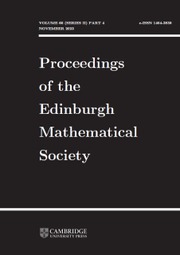No CrossRef data available.
Article contents
Maximal operators along flat curves with one variable vector field
Published online by Cambridge University Press: 13 November 2024
Abstract
We study a maximal average along a family of curves  $\{(t,m(x_1)\gamma(t)):t\in [-r,r]\}$, where
$\{(t,m(x_1)\gamma(t)):t\in [-r,r]\}$, where  $\gamma|_{[0,\infty)}$ is a convex function and m is a measurable function. Under the assumption of the doubling property of
$\gamma|_{[0,\infty)}$ is a convex function and m is a measurable function. Under the assumption of the doubling property of  $\gamma'$ and
$\gamma'$ and  $1\leqslant m(x_1)\leqslant 2$, we prove the
$1\leqslant m(x_1)\leqslant 2$, we prove the  $L^p(\mathbb{R}^2)$ boundedness of the maximal average. As a corollary, we obtain the pointwise convergence of the average in r > 0 without any size assumption for a measurable m.
$L^p(\mathbb{R}^2)$ boundedness of the maximal average. As a corollary, we obtain the pointwise convergence of the average in r > 0 without any size assumption for a measurable m.
- Type
- Research Article
- Information
- Proceedings of the Edinburgh Mathematical Society , Volume 67 , Issue 4 , November 2024 , pp. 1212 - 1228
- Copyright
- © The Author(s), 2024. Published by Cambridge University Press on Behalf of The Edinburgh Mathematical Society.
References
A correction has been issued for this article:
Linked content
Please note a has been issued for this article.



